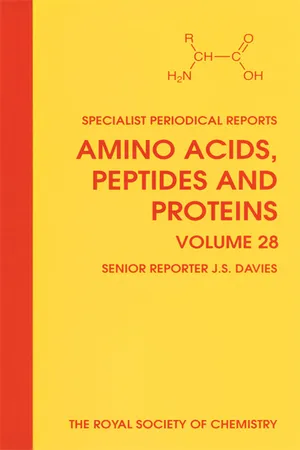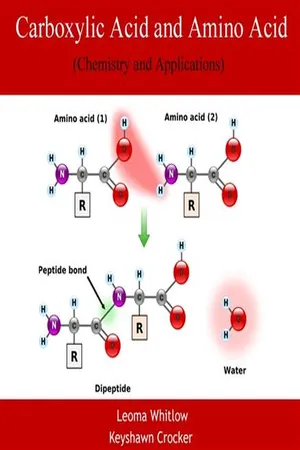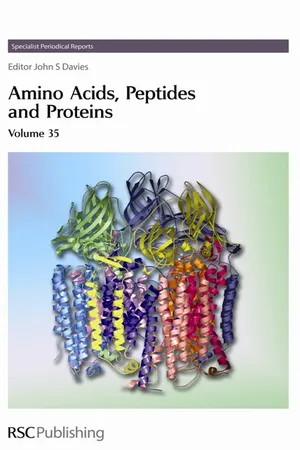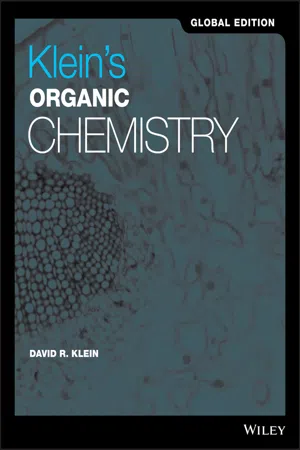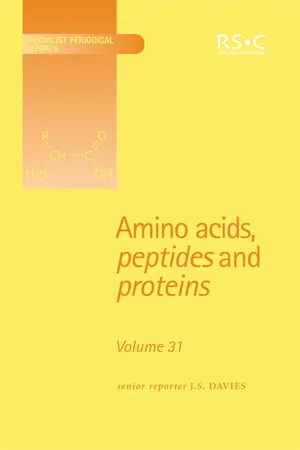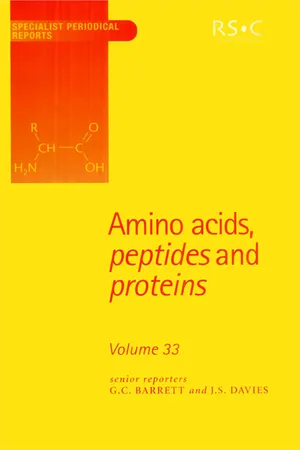Chemistry
Alpha Amino Acid Synthesis
Alpha amino acid synthesis refers to the process of creating alpha amino acids, which are the building blocks of proteins. This synthesis can occur through various methods, including the Strecker synthesis, Gabriel synthesis, and the biosynthesis pathway in living organisms. These methods involve the combination of specific chemical compounds to form the desired alpha amino acids.
Written by Perlego with AI-assistance
Related key terms
1 of 5
11 Key excerpts on "Alpha Amino Acid Synthesis"
- Rifat Latifi, Stanley J. Dudrick(Authors)
- 2003(Publication Date)
- CRC Press(Publisher)
When one realizes that muscle, bone, blood, brain, genes, and other tissues are all composed of amino acids, it is not difficult to understand the importance of acquir ing knowledge of amino acid biochemistry and metabolism, not only for biochem ists and basic scientists, but also for surgeons and other physicians. Amino Acid and Protein Synthesis Amino acids are building blocks for protein. All proteins are initially synthesized from 20 amino acids known as common or primary amino acids. Primary amino acids are defined as amino acids for which a specific codon exists in the DNA ge netic code. The genetic code is a directory that provides the correspondence be tween a sequence of nucleotide bases and a sequence of amino acids. The codons represent genetic words in a code composed of three nucleotide bases which are transcribed from DNA into the messenger RNA (mRNA), and their sequence is always read from its 5’-end (amino-terminal end) to its З’-end (carboxyl-terminal end). Codons exist for all 20 of the amino acids in the human body. Genetic infor mation is transmitted from the DNA sequence by mRNA translation into the amino acid sequence of a protein. The genetic code is thought to be specific, usually uni versal, redundant or degenerate, non-overlapping and commaless. Conventionally, the code is read from a fixed starting point as a continuous sequence of bases, taken three at a time. Protein synthesis is a highly complex biochemical process that requires 1. an amino acid sequence information, as coded by mRNA, 2. activated amino acids assembled as aminoacyl transfer RNA (tRNA) complex 3. energy in the form of guanosine triphosphate (GTP), and 4. various protein initiation or release factors. Protein synthesis occurs on the surface of ribosome, or multiprotein, multi-RNA complexes that provide the enzyme, peptidyl-transferase. This enzyme is one of many proteins of the larger ribosomal subunit and is imbedded in the surface of the sub unit.- eBook - PDF
Amino Acids, Peptides and Proteins
Volume 28
- J S Davies(Author)
- 2007(Publication Date)
- Royal Society of Chemistry(Publisher)
20 Amino Acids, Peptides and Proteins offer attractive targets to test synthetic methodology since the properties of the products are so well understood. Syntheses of natural a-amino acids of these types are also described in the preceding two Sections and in later Sections, especially in Section 6.3. As usual, enzymic catalysis blithely ignores stringent challenges when exploited in syntheses of natural a-amino acids relevant to the specificity of particular enzymes, and representative citations from the rapidly expanding literature on this topic deal with L-tyrosine and its 2- and 3-fluoro-, 3,5-difluoro-, 2-chloro-, 2- methyl- and 3-methyl-derivatives prepared from ammonium pyruvate and the appropriate phenol using Citrobacter intermedius, a source of tyrosine phenol- lyase;I6O with L-phenylalanine from N-acetamidocinnamic acid, using a Coryne- bacterium sp.;161 with L-tryptophan using Corynebacterium mutants;’62and with a hydrogenase - glutamate dehydrogenase cocktail for the reductive amination of 2-oxoglutaric acid to give L-glutamic acid.’63 [ ”N]-L-Valine can be produced from [ 15N]-ammonium sulfate through the agency of Corynebacterium peki- nense. 164 Section 16 of Chemical Abstracts: Fermentation and Bioindustrial Chemistry (and other Sections also, Section 10: Microbial, Algal, and Fungal Biochemistry in particular) give access to the full literature (including the patent literature) on this topic, which can only be hinted at here. A review of the production of microbial amino acids using heterotrophic bacteria has ap- peared. 165 Glutamic acid, alanine and glycine are generated in low yield in aqueous solutions of corresponding keto-acids, ammonia and reducing agents,’66 and the keto-acids required for the genesis of branched-chain amino acids are suggested to evolve through reductive carboxylation of alkanoic acids. - eBook - PDF
Amino Acids and Peptides
Volume 23
- J H Jones(Author)
- 2007(Publication Date)
- Royal Society of Chemistry(Publisher)
20 Amino Acids and Peptides stere~is~mer,~~~ and analogously for the synthesis of the 6-oxygenated analogue from (8s , 22 )-PhCH2OCHz.CHMe , CWCH, COdle , I 33 Several examples of the us@ of protein amino acids with side-chain functional groups, for the synthesis of more complex non-protein amino acids, emphasis@ the growing importance of this approach. Indeed, some examples have barn included in a preceding section (8.1 General Methods of Synthesis of Amino Acids) since they could be Judged to have entered into this category. c synthesis, from L-aspartic acid, of de- alanylalahopcin, the non-protein moiety of the dipeptide, has been described (Scheme 15) ,I3* Notable features are the diastereoaelective alkylation of the aretidinone and thiolate-catalyzed ring opening with benzylhydroxylamine via the readily aminolyzed thiolester. Protrcted L-pyroglutamic acid is ef f ic iently alkylated in terms both of yield and trans-stereosclectivity, after Y-anion formation using LiNPr'z or LiNBu';. in THF,' FI not-too-distant relative is Bulgecin C, for which the first total synthesis is reported, starting from 12S,bR)- hydroxyproline.'l This synthesis exploits the electrochemical methoxylation of the protected hydroxyproline acetate and ensuing routine elaboration. - No longer available |Learn more
- (Author)
- 2014(Publication Date)
- Academic Studio(Publisher)
____________________ WORLD TECHNOLOGIES ____________________ Chapter 11 Reactions Involving Amino Acids Peptide synthesis In organic chemistry, peptide synthesis is the production of peptides, which are organic compounds in which multiple amino acids are linked via peptide bonds which are also known as amide bonds. The biological process of producing long peptides (proteins) is known as protein biosynthesis. Solid-Phase Peptide Syntesis on a Rink amide resin using Fmoc-α -amine-protected amino acid Chemistry Peptides are synthesized by coupling the carboxyl group or C-terminus of one amino acid to the amino group or N-terminus of another. Due to the possibility of unintended reactions, protecting groups are usually necessary. Chemical peptide synthesis starts at the C-terminal end of the peptide and ____________________ WORLD TECHNOLOGIES ____________________ ends at the N-terminus. This is the opposite of protein biosynthesis, which starts at the N-terminal end. Liquid-phase synthesis Liquid-phase peptide synthesis is a classical approach to peptide synthesis. It has been replaced in most labs by solid-phase synthesis (see below). However, it retains usefulness in large-scale production of peptides for industrial purposes. Solid-phase synthesis Coupling step in solid-phase peptide synthesis Solid-phase peptide synthesis (SPPS), pioneered by Robert Bruce Merrifield, resulted in a paradigm shift within the peptide synthesis community. It is now the accepted method for creating peptides and proteins in the lab in a synthetic manner. SPPS allows the synthesis of natural peptides which are difficult to express in bacteria, the incorporation of ____________________ WORLD TECHNOLOGIES ____________________ unnatural amino acids, peptide/protein backbone modification, and the synthesis of D-proteins, which consist of D-amino acids. Small solid beads, insoluble yet porous, are treated with functional units ('linkers') on which peptide chains can be built. - eBook - PDF
Amino Acids, Peptides and Proteins
Volume 35
- J S Davies(Author)
- 2007(Publication Date)
- Royal Society of Chemistry(Publisher)
Image reproduced by permission of Amy Rosenzweig from Dalton Transactions , 2005. Amino Acids, Peptides and Proteins, Volume 35 r The Royal Society of Chemistry, 2006 vii 4.9 Synthesis of a -Amino Acids carrying Unsaturated Alipha-tic Side Chains 24 4.10 Synthesis of a -Amino Acids with Aromatic or Heterocyc-lic Side-Chains 27 4.11 Synthesis of a -Amino Acids carrying Amino Groups and related Nitrogen Functional Groups in Aliphatic Side Chains 32 4.12 Synthesis of a -Amino Acids with Side-Chains carrying Boron Functional Groups 33 4.13 Synthesis of a -Amino Acids with Side Chains carrying Silicon Functional Groups 33 4.14 Synthesis of a -Amino Acids with Side Chains carrying Phosphorus Functional Groups 33 4.15 Synthesis of a -Amino Acids carrying Sulfur and Selenium containing Side Chains 34 4.16 Synthesis of b -Amino Acids with Higher Homologous Amino Acids 35 4.17 Resolution of DL-Amino Acids 38 5 Physico-Chemical Studies of Amino Acids 41 5.1 X-ray Crystal Analysis of Amino Acids and Their Deri-vatives 41 5.2 Nuclear Magnetic Resonance Spectroscopy 41 5.3 Circular Dichroism 42 5.4 Mass Spectrometry 42 5.5 Other Spectroscopic Studies on Amino Acids 42 5.6 Measurements on Amino Acids in Solution 42 5.7 Measurements on Amino Acids in the Solid State 44 5.8 Amino Acids Adsorption and Transport Phenomena 45 5.9 Host-Guest Studies with Amino Acids 46 5.10 Theoretical Calculations involving Amino Acids 48 6 Reactions and Analysis of Amino Acids 49 6.1 General and Specific Reactions of Amino Acids 49 6.2 Analysis of Amino Acids 50 References 50 Peptide Synthesis 74 Donald T Elmore 1 Introduction 74 2 Methods 74 2.1 Amino-group Protection 74 2.2 Carboxy-group Protection 76 2.3 Side-chain Protection 77 2.4 Disulfide Bond Formation 77 viii Amino Acids, Pept. Proteins, 2006, 35 , vii–xii - No longer available |Learn more
- (Author)
- 2014(Publication Date)
- College Publishing House(Publisher)
____________________ WORLD TECHNOLOGIES ____________________ Chapter 4 Reactions Involving Amino Acids Peptide synthesis In organic chemistry, peptide synthesis is the production of peptides, which are organic compounds in which multiple amino acids are linked via peptide bonds which are also known as amide bonds. The biological process of producing long peptides (proteins) is known as protein biosynthesis. Solid-Phase Peptide Syntesis on a Rink amide resin using Fmoc-α -amine-protected amino acid Chemistry Peptides are synthesized by coupling the carboxyl group or C-terminus of one amino acid to the amino group or N-terminus of another. Due to the possibility of unintended reactions, protecting groups are usually necessary. Chemical peptide ____________________ WORLD TECHNOLOGIES ____________________ synthesis starts at the C-terminal end of the peptide and ends at the N-terminus. This is the opposite of protein biosynthesis, which starts at the N-terminal end. Liquid-phase synthesis Liquid-phase peptide synthesis is a classical approach to peptide synthesis. It has been replaced in most labs by solid-phase synthesis (see below). However, it retains usefulness in large-scale production of peptides for industrial purposes. Solid-phase synthesis Coupling step in solid-phase peptide synthesis Solid-phase peptide synthesis (SPPS), pioneered by Robert Bruce Merrifield, resulted in a paradigm shift within the peptide synthesis community. It is now the accepted method for creating peptides and proteins in the lab in a synthetic manner. SPPS allows the synthesis of natural peptides which are difficult to express in bacteria, the incorporation of unnatural amino acids, peptide/protein ____________________ WORLD TECHNOLOGIES ____________________ backbone modification, and the synthesis of D-proteins, which consist of D-amino acids. Small solid beads, insoluble yet porous, are treated with functional units ('linkers') on which peptide chains can be built. - eBook - PDF
- David R. Klein(Author)
- 2016(Publication Date)
- Wiley(Publisher)
Amino acids of this type are called α-amino acids because the amino group is connected to the car- bon atom that is alpha (α) to the carboxylic acid group. Notice that this α carbon is a chiral center, provided that the R group is not simply a hydrogen atom. The configuration of the α position will be discussed in the coming sections. Amino acids are coupled together by amide linkages, also called peptide bonds: Peptide bonds N C N C N O O R R C H H R O H 25.2 Structure and Properties of Amino Acids 1149 Relatively short amino acid chains are called peptides. A dipeptide is formed when two amino acids are coupled together, a tripeptide from three amino acids, a tetrapeptide from four, and so on. Chains comprised of fewer than 40 or 50 amino acids are often called polypeptides, while still larger chains are called proteins. Proteins serve a wide array of important biological functions, as we will discuss in the final section of this chapter. Certain proteins, called enzymes, serve as catalysts for most of the reactions that occur in living cells, and it is estimated that more than 50,000 different enzymes are needed for our bodies to function properly. In order to understand the structure and function of proteins, we must first explore the structure and properties of the most basic building blocks, amino acids. 25.2 Structure and Properties of Amino Acids Naturally Occurring Amino Acids Hundreds of different amino acids are observed in nature, but only 20 amino acids are abundantly found in proteins. These twenty α-amino acids differ from each other only in the identity of the side chain (the R group, highlighted). H N H C C R O OH H The structures of all 20 amino acids are shown in Table 25.1, together with the accepted three-letter abbreviation and one-letter abbreviation for each amino acid. Except for glycine (R = H), all of these amino acids are chiral, and nature typically employs only one enantiomer of each. - eBook - PDF
- David R. Klein(Author)
- 2020(Publication Date)
- Wiley(Publisher)
The relationship between structure and activity is perhaps most striking for biological molecules called proteins. Proteins are polymers that are assembled from amino acid monomers that have been linked together, much like jigsaw puzzle pieces (Figure 25.1). Each amino acid contains an amino group and a carboxylic acid group. FIGURE 25.1 An illustration showing how amino acids serve as building blocks for proteins. H N H C C R O OH H Amino acid H N H C C R O OH H Amino acid Protein N H C C R O H N H C C R O H N H C C R O H OH C C R O H N H H N H C C R O H It is the presence of these two functional groups that enables amino acids to link together. An amino acid can have any number of carbon atoms separating the two functional groups, but of particular interest are the alpha (α) amino acids in which the two functional groups are separated by exactly one carbon atom. H N H C C R O OH H COOH R H 2 N An α-amino acid Functional groups are separated by only one carbon atom. Amino acids of this type are called α-amino acids because the amino group is connected to the car- bon atom that is alpha (α) to the carboxylic acid group. Notice that this α carbon is a chiral center, provided that the R group is not simply a hydrogen atom. The configuration of the α position will be discussed in the coming sections. Amino acids are coupled together by amide linkages, also called peptide bonds: Peptide bonds N C N C N O O R R C H H R O H 1140 CHAPTER 25 Amino Acids, Peptides, and Proteins Relatively short amino acid chains are called peptides. A dipeptide is formed when two amino acids are coupled together, a tripeptide from three amino acids, a tetrapeptide from four, and so on. Chains comprised of fewer than 40 or 50 amino acids are often called polypeptides, while still larger chains are called proteins. Proteins serve a wide array of important biological functions, as we will discuss in the final section of this chapter. - eBook - PDF
Amino Acids, Peptides and Proteins
Volume 31
- J S Davies(Author)
- 2007(Publication Date)
- Royal Society of Chemistry(Publisher)
Some newly- introduced synthesis methods are described. As in last year's Volume, syntheses of isotopically-labelled coded amino acids are not collected in a separate subsection, but are spread throughout the Chapter: 2H, Refs. 98, 370, 599, 945, 946, 1034, 1097; 3H, Ref. 1105; I'C, 4 Amino Acids, Peptides and Proteins Ref. 161; I3C, Refs. 122, 124, 126, 131, 599, 1098; I4C, Refs. 123, 1105; I5N, Refs. 122, 124, 131, 160, 235; l80, Ref. 599; **F, Refs. 1011, 1038; I2*I, Ref. 1035. General reviews of synthesis methods applied to a-amino acids have appeared: asymmetric synthesis,32 general strategies of synthesis of a-amino acids and a-methyl-a-amino acids,33use of sulfinimines in asymmetric synth- e ~ i s , ~ ~ 2-(a-aminoalkyl)thiazoles as masked a-aminoaldehyde~,~~ and use of the Mitsunobu reaction.36 4.1 General Methods for the Synthesis of a-Amino Acids, Including Enantio- selective Synthesis - 4.1.1 Amination of Alkanoic Acid Derivatives by Amines and Amine-related Reagents - Descriptions of simple syntheses of common amino acids are to be found in the recent literature, and some of these emerge from the continuing fascination of prebiotic amino acid synthesis (Section 4.5). a-Phenylglycine, H3N+CHPhC02-, is formed from the reaction of phenylacetic acid with Br2 and NH3,37 and 3,5-dihydroxy-4-methoxybenzaldehyde leads on to the correspondingly-substituted phenylglycine through reaction with ammonia and toluene-p-sulfonyl cyanide (Strecker synthesis, see also Section 4.1.6).38 Palladium(0)-catalysed azidation of (2s)- 1 -ethoxycarbonylmethylidine-2- methylcyclopropanes is a notable feature of a route to (-)-( lR,2S)-norcoro- namic acid (Scheme l).39 Similar treatment of the a-chloroester formed by m-chloroperbenzoic acid oxidation of sugar-derived dichloroalkenes (Scheme 2) makes use of a remarkably simple C = O + >CHC02Me procedure.40 4.. - eBook - PDF
Amino Acids, Peptides and Proteins
Volume 33
- G C Barrett, J S Davies(Authors)
- 2007(Publication Date)
- Royal Society of Chemistry(Publisher)
267 4.7 Synthesis of -( -Hydroxyalkyl) -Amino Acids. — A highly stereoselective synthesis of , -unsaturated amino acids involving the asymmetrical Claisen rearrangement of allylic esters of TFA-protected amino acids in the presence of Amino Acids , Peptides and Proteins 16 cinchona alkaloids has been reported. 268 The synthesis of (2 R ,3 S )- -hydroxy leucine and all four isomers of -phenyl serine, using the sulfinimine-mediated Strecker synthesis, 269 3,4-dihydroxypro-lines by application of an -threonine aldolase-catalysed aldol reaction 270 and ( 27 ), from methyl ( E )-4-methoxy cinnamate via the Sharpless asymmetric aminohydroxylation reaction, 271 have been reported. -Hydroxyaspartic acid derivatives have been synthesised and tested as gluta-mate transport blockers. 272 On addition of Et 2 AlCN/I-PrOH, masked oxo sul-finimines gave -amino nitriles that afforded oxo -amino acids on hydrolysis. 273 4.8 Synthesis of N -Substituted -Amino Acids. — A general route for the solid phase synthesis of N -substituted -amino acids using Fukuyama’s sulfonide protecting group has been reported. 274 More specific synthetic methods for N -methyl- -amino acids from N -carbamoyl -amino acids via oxazolidinones, 275 N -hydroxyamino acids via the selective N -hydroxylation of N -Boc protected primary amino acid esters with methyl(trifluoromethyl)-dioxirane under mild conditions 276 and N ( )-alkyl histamine and histidine derivatives through efficient alkylation followed by deprotection using activated silica gel 277 have been pres-ented. The synthesis of derivatives of arginine containing several chiral centers has been reported. 278 Reaction of -amino acids with ketones under hydrogenation conditions using 20% Pd(OH) 2 /C gave N -monoalkylated amino acids; methylation under the same conditions gave N , N -dialkylated derivatives. - eBook - PDF
Amino Acids and Peptides
Volume 21
- J H Jones(Author)
- 2007(Publication Date)
- Royal Society of Chemistry(Publisher)
Amino Acids 13 literature on biotechnological production of protein amino acids, but as usual, only representative papers are cited here [readers are reminded of the easy access to this topic through Section 16 of Ghemkal (Biotechnology and Industrial Fermentations)l. Re~iews~’-~~ have appeared, of large scale production of L-trypt~phan,’~,.~ L- phenylalanineIa9and of natural a-amino acids generally. By large scale in one of these reviews is meant 200 tons y-l (of methionine, phenylalanine, or valineIy’ produced by acylase ’resolution’ of a-acetyl-DL-amino acid esters). The continuing importance of enzyme-catalyzed production of L-amino acids from DL-hydantoins,8e~sz~sb~9n and from keto-acids, y 3 , y 6 0 y 7 ~ s y and more emphasis on unusual amino acids, ’ O production of D-amino acids, 30~y4~ye~yy and reactor design, y1 loo is reflected in these reviews, and is also noticeable i n the primary literature citations given. Particular commercial importance associated with L-WPA,ys glutamic acid, Io1 arginine, alanine, lo3 and aspartic acid, lo’ and several other protein amino acids, is reflected in these papers, but work on less common amino acids such as D- and L-pipecolic acid (the latter converted into L-aminoadipic acid)se is notable. Just as the preceding citations are a small fraction of the total literature, research on amino acid biosynthesis pathways cannot be more than hinted at here. The first stage in conversion of crotonobetaine into L-carnitine by enterobacteria is hydroxylation of the double bond. l o b Further representative citations in this topic area can be found later in this Chapter (Section 6.2). Reduction of methyl hydroximino-cyanoacetate HOB=C(CN)COZH~ at a lead or carbon cathode gives the amine, which by acetylation and further reduction gives the protected viomycin constituent, 2,3-diaminopropionic acid.1os Other syntheses of relatively
Index pages curate the most relevant extracts from our library of academic textbooks. They’ve been created using an in-house natural language model (NLM), each adding context and meaning to key research topics.

